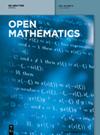求助PDF
{"title":"大指数双相特征值问题","authors":"Lujuan Yu","doi":"10.1515/math-2023-0138","DOIUrl":null,"url":null,"abstract":"In the present article, we consider a double-phase eigenvalue problem with large exponents. Let <jats:inline-formula> <jats:alternatives> <jats:inline-graphic xmlns:xlink=\"http://www.w3.org/1999/xlink\" xlink:href=\"graphic/j_math-2023-0138_eq_001.png\" /> <m:math xmlns:m=\"http://www.w3.org/1998/Math/MathML\"> <m:msubsup> <m:mrow> <m:mi>λ</m:mi> </m:mrow> <m:mrow> <m:mrow> <m:mo>(</m:mo> <m:mrow> <m:msub> <m:mrow> <m:mi>p</m:mi> </m:mrow> <m:mrow> <m:mi>n</m:mi> </m:mrow> </m:msub> <m:mo>,</m:mo> <m:msub> <m:mrow> <m:mi>q</m:mi> </m:mrow> <m:mrow> <m:mi>n</m:mi> </m:mrow> </m:msub> </m:mrow> <m:mo>)</m:mo> </m:mrow> </m:mrow> <m:mrow> <m:mn>1</m:mn> </m:mrow> </m:msubsup> </m:math> <jats:tex-math>{\\lambda }_{\\left({p}_{n},{q}_{n})}^{1}</jats:tex-math> </jats:alternatives> </jats:inline-formula> be the first eigenvalues and <jats:inline-formula> <jats:alternatives> <jats:inline-graphic xmlns:xlink=\"http://www.w3.org/1999/xlink\" xlink:href=\"graphic/j_math-2023-0138_eq_002.png\" /> <m:math xmlns:m=\"http://www.w3.org/1998/Math/MathML\"> <m:msub> <m:mrow> <m:mi>u</m:mi> </m:mrow> <m:mrow> <m:mi>n</m:mi> </m:mrow> </m:msub> </m:math> <jats:tex-math>{u}_{n}</jats:tex-math> </jats:alternatives> </jats:inline-formula> be the first eigenfunctions, normalized by <jats:inline-formula> <jats:alternatives> <jats:inline-graphic xmlns:xlink=\"http://www.w3.org/1999/xlink\" xlink:href=\"graphic/j_math-2023-0138_eq_003.png\" /> <m:math xmlns:m=\"http://www.w3.org/1998/Math/MathML\"> <m:msub> <m:mrow> <m:mo>‖</m:mo> <m:msub> <m:mrow> <m:mi>u</m:mi> </m:mrow> <m:mrow> <m:mi>n</m:mi> </m:mrow> </m:msub> <m:mo>‖</m:mo> </m:mrow> <m:mrow> <m:msub> <m:mrow> <m:mi mathvariant=\"script\">ℋ</m:mi> </m:mrow> <m:mrow> <m:mi>n</m:mi> </m:mrow> </m:msub> </m:mrow> </m:msub> <m:mo>=</m:mo> <m:mn>1</m:mn> </m:math> <jats:tex-math>\\Vert {u}_{n}{\\Vert }_{{{\\mathcal{ {\\mathcal H} }}}_{n}}=1</jats:tex-math> </jats:alternatives> </jats:inline-formula>. Under some assumptions on the exponents <jats:inline-formula> <jats:alternatives> <jats:inline-graphic xmlns:xlink=\"http://www.w3.org/1999/xlink\" xlink:href=\"graphic/j_math-2023-0138_eq_004.png\" /> <m:math xmlns:m=\"http://www.w3.org/1998/Math/MathML\"> <m:msub> <m:mrow> <m:mi>p</m:mi> </m:mrow> <m:mrow> <m:mi>n</m:mi> </m:mrow> </m:msub> </m:math> <jats:tex-math>{p}_{n}</jats:tex-math> </jats:alternatives> </jats:inline-formula> and <jats:inline-formula> <jats:alternatives> <jats:inline-graphic xmlns:xlink=\"http://www.w3.org/1999/xlink\" xlink:href=\"graphic/j_math-2023-0138_eq_005.png\" /> <m:math xmlns:m=\"http://www.w3.org/1998/Math/MathML\"> <m:msub> <m:mrow> <m:mi>q</m:mi> </m:mrow> <m:mrow> <m:mi>n</m:mi> </m:mrow> </m:msub> </m:math> <jats:tex-math>{q}_{n}</jats:tex-math> </jats:alternatives> </jats:inline-formula>, we show that <jats:inline-formula> <jats:alternatives> <jats:inline-graphic xmlns:xlink=\"http://www.w3.org/1999/xlink\" xlink:href=\"graphic/j_math-2023-0138_eq_006.png\" /> <m:math xmlns:m=\"http://www.w3.org/1998/Math/MathML\"> <m:msubsup> <m:mrow> <m:mi>λ</m:mi> </m:mrow> <m:mrow> <m:mrow> <m:mo>(</m:mo> <m:mrow> <m:msub> <m:mrow> <m:mi>p</m:mi> </m:mrow> <m:mrow> <m:mi>n</m:mi> </m:mrow> </m:msub> <m:mo>,</m:mo> <m:msub> <m:mrow> <m:mi>q</m:mi> </m:mrow> <m:mrow> <m:mi>n</m:mi> </m:mrow> </m:msub> </m:mrow> <m:mo>)</m:mo> </m:mrow> </m:mrow> <m:mrow> <m:mn>1</m:mn> </m:mrow> </m:msubsup> </m:math> <jats:tex-math>{\\lambda }_{\\left({p}_{n},{q}_{n})}^{1}</jats:tex-math> </jats:alternatives> </jats:inline-formula> converges to <jats:inline-formula> <jats:alternatives> <jats:inline-graphic xmlns:xlink=\"http://www.w3.org/1999/xlink\" xlink:href=\"graphic/j_math-2023-0138_eq_007.png\" /> <m:math xmlns:m=\"http://www.w3.org/1998/Math/MathML\"> <m:msub> <m:mrow> <m:mi mathvariant=\"normal\">Λ</m:mi> </m:mrow> <m:mrow> <m:mi>∞</m:mi> </m:mrow> </m:msub> </m:math> <jats:tex-math>{\\Lambda }_{\\infty }</jats:tex-math> </jats:alternatives> </jats:inline-formula> and <jats:inline-formula> <jats:alternatives> <jats:inline-graphic xmlns:xlink=\"http://www.w3.org/1999/xlink\" xlink:href=\"graphic/j_math-2023-0138_eq_008.png\" /> <m:math xmlns:m=\"http://www.w3.org/1998/Math/MathML\"> <m:msub> <m:mrow> <m:mi>u</m:mi> </m:mrow> <m:mrow> <m:mi>n</m:mi> </m:mrow> </m:msub> </m:math> <jats:tex-math>{u}_{n}</jats:tex-math> </jats:alternatives> </jats:inline-formula> converges to <jats:inline-formula> <jats:alternatives> <jats:inline-graphic xmlns:xlink=\"http://www.w3.org/1999/xlink\" xlink:href=\"graphic/j_math-2023-0138_eq_009.png\" /> <m:math xmlns:m=\"http://www.w3.org/1998/Math/MathML\"> <m:msub> <m:mrow> <m:mi>u</m:mi> </m:mrow> <m:mrow> <m:mi>∞</m:mi> </m:mrow> </m:msub> </m:math> <jats:tex-math>{u}_{\\infty }</jats:tex-math> </jats:alternatives> </jats:inline-formula> uniformly in the space <jats:inline-formula> <jats:alternatives> <jats:inline-graphic xmlns:xlink=\"http://www.w3.org/1999/xlink\" xlink:href=\"graphic/j_math-2023-0138_eq_010.png\" /> <m:math xmlns:m=\"http://www.w3.org/1998/Math/MathML\"> <m:msup> <m:mrow> <m:mi>C</m:mi> </m:mrow> <m:mrow> <m:mi>α</m:mi> </m:mrow> </m:msup> <m:mrow> <m:mo>(</m:mo> <m:mrow> <m:mi mathvariant=\"normal\">Ω</m:mi> </m:mrow> <m:mo>)</m:mo> </m:mrow> </m:math> <jats:tex-math>{C}^{\\alpha }\\left(\\Omega )</jats:tex-math> </jats:alternatives> </jats:inline-formula>, and <jats:inline-formula> <jats:alternatives> <jats:inline-graphic xmlns:xlink=\"http://www.w3.org/1999/xlink\" xlink:href=\"graphic/j_math-2023-0138_eq_011.png\" /> <m:math xmlns:m=\"http://www.w3.org/1998/Math/MathML\"> <m:msub> <m:mrow> <m:mi>u</m:mi> </m:mrow> <m:mrow> <m:mi>∞</m:mi> </m:mrow> </m:msub> </m:math> <jats:tex-math>{u}_{\\infty }</jats:tex-math> </jats:alternatives> </jats:inline-formula> is a nontrivial viscosity solution to a Dirichlet <jats:inline-formula> <jats:alternatives> <jats:inline-graphic xmlns:xlink=\"http://www.w3.org/1999/xlink\" xlink:href=\"graphic/j_math-2023-0138_eq_012.png\" /> <m:math xmlns:m=\"http://www.w3.org/1998/Math/MathML\"> <m:mi>∞</m:mi> </m:math> <jats:tex-math>\\infty </jats:tex-math> </jats:alternatives> </jats:inline-formula>-Laplacian problem.","PeriodicalId":48713,"journal":{"name":"Open Mathematics","volume":"108 1","pages":""},"PeriodicalIF":0.9000,"publicationDate":"2023-12-06","publicationTypes":"Journal Article","fieldsOfStudy":null,"isOpenAccess":false,"openAccessPdf":"","citationCount":"0","resultStr":"{\"title\":\"A double-phase eigenvalue problem with large exponents\",\"authors\":\"Lujuan Yu\",\"doi\":\"10.1515/math-2023-0138\",\"DOIUrl\":null,\"url\":null,\"abstract\":\"In the present article, we consider a double-phase eigenvalue problem with large exponents. Let <jats:inline-formula> <jats:alternatives> <jats:inline-graphic xmlns:xlink=\\\"http://www.w3.org/1999/xlink\\\" xlink:href=\\\"graphic/j_math-2023-0138_eq_001.png\\\" /> <m:math xmlns:m=\\\"http://www.w3.org/1998/Math/MathML\\\"> <m:msubsup> <m:mrow> <m:mi>λ</m:mi> </m:mrow> <m:mrow> <m:mrow> <m:mo>(</m:mo> <m:mrow> <m:msub> <m:mrow> <m:mi>p</m:mi> </m:mrow> <m:mrow> <m:mi>n</m:mi> </m:mrow> </m:msub> <m:mo>,</m:mo> <m:msub> <m:mrow> <m:mi>q</m:mi> </m:mrow> <m:mrow> <m:mi>n</m:mi> </m:mrow> </m:msub> </m:mrow> <m:mo>)</m:mo> </m:mrow> </m:mrow> <m:mrow> <m:mn>1</m:mn> </m:mrow> </m:msubsup> </m:math> <jats:tex-math>{\\\\lambda }_{\\\\left({p}_{n},{q}_{n})}^{1}</jats:tex-math> </jats:alternatives> </jats:inline-formula> be the first eigenvalues and <jats:inline-formula> <jats:alternatives> <jats:inline-graphic xmlns:xlink=\\\"http://www.w3.org/1999/xlink\\\" xlink:href=\\\"graphic/j_math-2023-0138_eq_002.png\\\" /> <m:math xmlns:m=\\\"http://www.w3.org/1998/Math/MathML\\\"> <m:msub> <m:mrow> <m:mi>u</m:mi> </m:mrow> <m:mrow> <m:mi>n</m:mi> </m:mrow> </m:msub> </m:math> <jats:tex-math>{u}_{n}</jats:tex-math> </jats:alternatives> </jats:inline-formula> be the first eigenfunctions, normalized by <jats:inline-formula> <jats:alternatives> <jats:inline-graphic xmlns:xlink=\\\"http://www.w3.org/1999/xlink\\\" xlink:href=\\\"graphic/j_math-2023-0138_eq_003.png\\\" /> <m:math xmlns:m=\\\"http://www.w3.org/1998/Math/MathML\\\"> <m:msub> <m:mrow> <m:mo>‖</m:mo> <m:msub> <m:mrow> <m:mi>u</m:mi> </m:mrow> <m:mrow> <m:mi>n</m:mi> </m:mrow> </m:msub> <m:mo>‖</m:mo> </m:mrow> <m:mrow> <m:msub> <m:mrow> <m:mi mathvariant=\\\"script\\\">ℋ</m:mi> </m:mrow> <m:mrow> <m:mi>n</m:mi> </m:mrow> </m:msub> </m:mrow> </m:msub> <m:mo>=</m:mo> <m:mn>1</m:mn> </m:math> <jats:tex-math>\\\\Vert {u}_{n}{\\\\Vert }_{{{\\\\mathcal{ {\\\\mathcal H} }}}_{n}}=1</jats:tex-math> </jats:alternatives> </jats:inline-formula>. Under some assumptions on the exponents <jats:inline-formula> <jats:alternatives> <jats:inline-graphic xmlns:xlink=\\\"http://www.w3.org/1999/xlink\\\" xlink:href=\\\"graphic/j_math-2023-0138_eq_004.png\\\" /> <m:math xmlns:m=\\\"http://www.w3.org/1998/Math/MathML\\\"> <m:msub> <m:mrow> <m:mi>p</m:mi> </m:mrow> <m:mrow> <m:mi>n</m:mi> </m:mrow> </m:msub> </m:math> <jats:tex-math>{p}_{n}</jats:tex-math> </jats:alternatives> </jats:inline-formula> and <jats:inline-formula> <jats:alternatives> <jats:inline-graphic xmlns:xlink=\\\"http://www.w3.org/1999/xlink\\\" xlink:href=\\\"graphic/j_math-2023-0138_eq_005.png\\\" /> <m:math xmlns:m=\\\"http://www.w3.org/1998/Math/MathML\\\"> <m:msub> <m:mrow> <m:mi>q</m:mi> </m:mrow> <m:mrow> <m:mi>n</m:mi> </m:mrow> </m:msub> </m:math> <jats:tex-math>{q}_{n}</jats:tex-math> </jats:alternatives> </jats:inline-formula>, we show that <jats:inline-formula> <jats:alternatives> <jats:inline-graphic xmlns:xlink=\\\"http://www.w3.org/1999/xlink\\\" xlink:href=\\\"graphic/j_math-2023-0138_eq_006.png\\\" /> <m:math xmlns:m=\\\"http://www.w3.org/1998/Math/MathML\\\"> <m:msubsup> <m:mrow> <m:mi>λ</m:mi> </m:mrow> <m:mrow> <m:mrow> <m:mo>(</m:mo> <m:mrow> <m:msub> <m:mrow> <m:mi>p</m:mi> </m:mrow> <m:mrow> <m:mi>n</m:mi> </m:mrow> </m:msub> <m:mo>,</m:mo> <m:msub> <m:mrow> <m:mi>q</m:mi> </m:mrow> <m:mrow> <m:mi>n</m:mi> </m:mrow> </m:msub> </m:mrow> <m:mo>)</m:mo> </m:mrow> </m:mrow> <m:mrow> <m:mn>1</m:mn> </m:mrow> </m:msubsup> </m:math> <jats:tex-math>{\\\\lambda }_{\\\\left({p}_{n},{q}_{n})}^{1}</jats:tex-math> </jats:alternatives> </jats:inline-formula> converges to <jats:inline-formula> <jats:alternatives> <jats:inline-graphic xmlns:xlink=\\\"http://www.w3.org/1999/xlink\\\" xlink:href=\\\"graphic/j_math-2023-0138_eq_007.png\\\" /> <m:math xmlns:m=\\\"http://www.w3.org/1998/Math/MathML\\\"> <m:msub> <m:mrow> <m:mi mathvariant=\\\"normal\\\">Λ</m:mi> </m:mrow> <m:mrow> <m:mi>∞</m:mi> </m:mrow> </m:msub> </m:math> <jats:tex-math>{\\\\Lambda }_{\\\\infty }</jats:tex-math> </jats:alternatives> </jats:inline-formula> and <jats:inline-formula> <jats:alternatives> <jats:inline-graphic xmlns:xlink=\\\"http://www.w3.org/1999/xlink\\\" xlink:href=\\\"graphic/j_math-2023-0138_eq_008.png\\\" /> <m:math xmlns:m=\\\"http://www.w3.org/1998/Math/MathML\\\"> <m:msub> <m:mrow> <m:mi>u</m:mi> </m:mrow> <m:mrow> <m:mi>n</m:mi> </m:mrow> </m:msub> </m:math> <jats:tex-math>{u}_{n}</jats:tex-math> </jats:alternatives> </jats:inline-formula> converges to <jats:inline-formula> <jats:alternatives> <jats:inline-graphic xmlns:xlink=\\\"http://www.w3.org/1999/xlink\\\" xlink:href=\\\"graphic/j_math-2023-0138_eq_009.png\\\" /> <m:math xmlns:m=\\\"http://www.w3.org/1998/Math/MathML\\\"> <m:msub> <m:mrow> <m:mi>u</m:mi> </m:mrow> <m:mrow> <m:mi>∞</m:mi> </m:mrow> </m:msub> </m:math> <jats:tex-math>{u}_{\\\\infty }</jats:tex-math> </jats:alternatives> </jats:inline-formula> uniformly in the space <jats:inline-formula> <jats:alternatives> <jats:inline-graphic xmlns:xlink=\\\"http://www.w3.org/1999/xlink\\\" xlink:href=\\\"graphic/j_math-2023-0138_eq_010.png\\\" /> <m:math xmlns:m=\\\"http://www.w3.org/1998/Math/MathML\\\"> <m:msup> <m:mrow> <m:mi>C</m:mi> </m:mrow> <m:mrow> <m:mi>α</m:mi> </m:mrow> </m:msup> <m:mrow> <m:mo>(</m:mo> <m:mrow> <m:mi mathvariant=\\\"normal\\\">Ω</m:mi> </m:mrow> <m:mo>)</m:mo> </m:mrow> </m:math> <jats:tex-math>{C}^{\\\\alpha }\\\\left(\\\\Omega )</jats:tex-math> </jats:alternatives> </jats:inline-formula>, and <jats:inline-formula> <jats:alternatives> <jats:inline-graphic xmlns:xlink=\\\"http://www.w3.org/1999/xlink\\\" xlink:href=\\\"graphic/j_math-2023-0138_eq_011.png\\\" /> <m:math xmlns:m=\\\"http://www.w3.org/1998/Math/MathML\\\"> <m:msub> <m:mrow> <m:mi>u</m:mi> </m:mrow> <m:mrow> <m:mi>∞</m:mi> </m:mrow> </m:msub> </m:math> <jats:tex-math>{u}_{\\\\infty }</jats:tex-math> </jats:alternatives> </jats:inline-formula> is a nontrivial viscosity solution to a Dirichlet <jats:inline-formula> <jats:alternatives> <jats:inline-graphic xmlns:xlink=\\\"http://www.w3.org/1999/xlink\\\" xlink:href=\\\"graphic/j_math-2023-0138_eq_012.png\\\" /> <m:math xmlns:m=\\\"http://www.w3.org/1998/Math/MathML\\\"> <m:mi>∞</m:mi> </m:math> <jats:tex-math>\\\\infty </jats:tex-math> </jats:alternatives> </jats:inline-formula>-Laplacian problem.\",\"PeriodicalId\":48713,\"journal\":{\"name\":\"Open Mathematics\",\"volume\":\"108 1\",\"pages\":\"\"},\"PeriodicalIF\":0.9000,\"publicationDate\":\"2023-12-06\",\"publicationTypes\":\"Journal Article\",\"fieldsOfStudy\":null,\"isOpenAccess\":false,\"openAccessPdf\":\"\",\"citationCount\":\"0\",\"resultStr\":null,\"platform\":\"Semanticscholar\",\"paperid\":null,\"PeriodicalName\":\"Open Mathematics\",\"FirstCategoryId\":\"100\",\"ListUrlMain\":\"https://doi.org/10.1515/math-2023-0138\",\"RegionNum\":4,\"RegionCategory\":\"数学\",\"ArticlePicture\":[],\"TitleCN\":null,\"AbstractTextCN\":null,\"PMCID\":null,\"EPubDate\":\"\",\"PubModel\":\"\",\"JCR\":\"Q1\",\"JCRName\":\"MATHEMATICS\",\"Score\":null,\"Total\":0}","platform":"Semanticscholar","paperid":null,"PeriodicalName":"Open Mathematics","FirstCategoryId":"100","ListUrlMain":"https://doi.org/10.1515/math-2023-0138","RegionNum":4,"RegionCategory":"数学","ArticlePicture":[],"TitleCN":null,"AbstractTextCN":null,"PMCID":null,"EPubDate":"","PubModel":"","JCR":"Q1","JCRName":"MATHEMATICS","Score":null,"Total":0}
引用次数: 0
引用
批量引用
A double-phase eigenvalue problem with large exponents
In the present article, we consider a double-phase eigenvalue problem with large exponents. Let λ ( p n , q n ) 1 {\lambda }_{\left({p}_{n},{q}_{n})}^{1} be the first eigenvalues and u n {u}_{n} be the first eigenfunctions, normalized by ‖ u n ‖ ℋ n = 1 \Vert {u}_{n}{\Vert }_{{{\mathcal{ {\mathcal H} }}}_{n}}=1 . Under some assumptions on the exponents p n {p}_{n} and q n {q}_{n} , we show that λ ( p n , q n ) 1 {\lambda }_{\left({p}_{n},{q}_{n})}^{1} converges to Λ ∞ {\Lambda }_{\infty } and u n {u}_{n} converges to u ∞ {u}_{\infty } uniformly in the space C α ( Ω ) {C}^{\alpha }\left(\Omega ) , and u ∞ {u}_{\infty } is a nontrivial viscosity solution to a Dirichlet ∞ \infty -Laplacian problem.

 求助内容:
求助内容: 应助结果提醒方式:
应助结果提醒方式:


